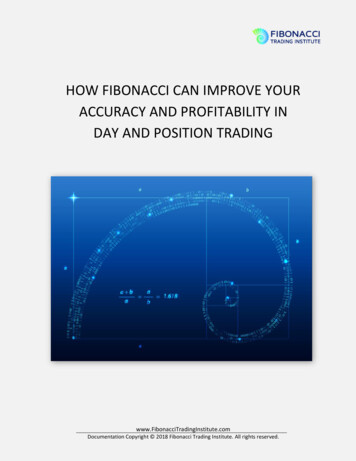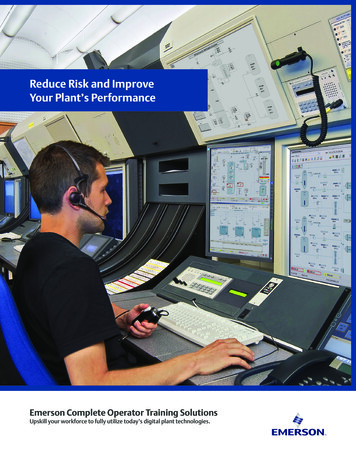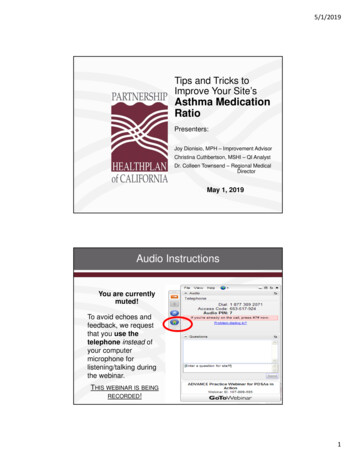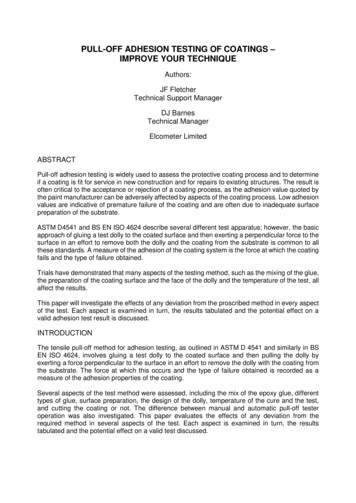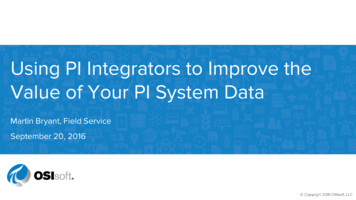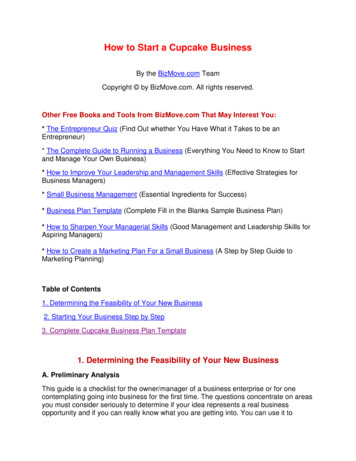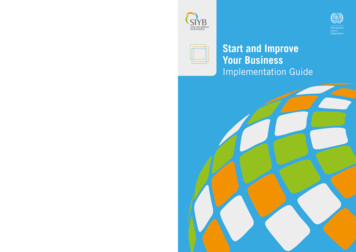
Transcription
Start and ImproveYour BusinessImplementation Guide
Start and ImproveYour BusinessImplementation GuideEva MajurinSmall and Medium Enterprises Unit (SME)Enterprises Department (ENTERPRISES), International Labour Office, Geneva
Copyright International Labour Organization 2014Start and Improve Your Business Implementation GuideiiFirst published 2014Publications of the International Labour Office enjoy copyright under Protocol 2 of the Universal Copyright Convention. Nevertheless, short excerpts from them may be reproduced without authorization, on condition that thesource is indicated. For rights of reproduction or translation, application should be made to ILO Publications (Rightsand Permissions), International Labour Office, CH-1211 Geneva 22, Switzerland, or by email: pubdroit@ilo.org. TheInternational Labour Office welcomes such applications.Libraries, institutions and other users registered with reproduction rights organizations may make copies in accordance with the licences issued to them for this purpose. Visit www.ifrro.org to find the reproduction rightsorganization in your country.Majurin, EvaStart and improve your business (SIYB): implementation guide / International Labour Office. Geneva: ILO, 2014ISBN: 9789221288060; 9789221288077 (web pdf)International Labour Officeenterprise development / entrepreneurship / small enterprise / employment creation / training system / trainingpackage / ILO Programme / developing countries03.04.5ILO Cataloguing in Publication DataThe designations employed in ILO publications, which are in conformity with United Nations practice, and the presentation of material therein do not imply the expression of any opinion whatsoever on the part of the InternationalLabour Office concerning the legal status of any country, area or territory or of its authorities, or concerning thedelimitation of its frontiers.The responsibility for opinions expressed in signed articles, studies and other contributions rests solely with theirauthors, and publication does not constitute an endorsement by the International Labour Office of the opinionsexpressed in them.Reference to names of firms and commercial products and processes does not imply their endorsement by theInternational Labour Office, and any failure to mention a particular firm, commercial product or process is not asign of disapproval.ILO publications and electronic products can be obtained through major booksellers or ILO local offices in manycountries, or direct from ILO Publications, International Labour Office, CH-1211 Geneva 22, Switzerland. Cataloguesor lists of new publications are available free of charge from the above address, or by email: pubvente@ilo.orgVisit our web site: www.ilo.org/publnsDesign and layout by Maurizio Costanza.Cover design by Maurizio Costanza with contribution (original globe design) by Miriam Christensen.
ForewordThis Guide is intended as a practical tool to support the implementation of theStart and Improve Your Business (SIYB) programme. It provides step-by-step guidance for the successful introduction of SIYB in a given context, from carrying outan initial market assessment to planning for sustainability. We trust that the Guidewill facilitate the introduction of the programme in new contexts and enhance itseffectiveness where it is already operational. The intended audience of this guideare Private Sector Development (PSD) practitioners in governments and private sector institutions who want to run the SIYB programme. Its ultimate beneficiaries arepotential and already established entrepreneurs who are equipped to create moreand better jobs.Recent research shows that the majority of jobs in the world are provided by Micro,Small and Medium Enterprises (MSMEs), and that in low income countries this shareis almost 80%. However, these entrepreneurs often face a number of challengeswhich prevent them from reaching their potential, including a limited access toBusiness Development Services (BDS) such as market information, legal advice, andmanagerial training.Demand for the SIYB programme continues to grow, including among new partnerssuch as government departments. Maintaining quality standards globally and providing support for the design and execution of SIYB interventions is therefore critical.Eva Majurin, the author of this Guide and SIYB Global Coordinator, has built on agroup of highly engaged practitioners and her own expertise to now put forward aguide that establishes the fundamentals of the programme and its quality standardsfor the years to come.Peter PoschenMerten SieversDirectorEnterprises DepartmentILO GenevaVCD and BDS CoordinatorSmall and Medium Enterprises UnitILO GenevaiiiStart and Improve Your Business Implementation GuideThe International Labour Office (ILO) has designed and tested responses to thesechallenges. In the area of business management skills, the SIYB programme hasbeen at the forefront of the ILO’s efforts to support potential and already establishedentrepreneurs in its member countries since the late 1970s. Today, the programmeis one of the largest of its kind worldwide. Through a network of over 17,000 SIYBtrainers across regions it has reached an estimated 6 million enterprise-level clients.
AcknowledgementsThis Guide is based on the experience of SIYB practitioners – in particular MasterTrainers and Trainers – who have tested, shaped, and rolled out the programmein different regions over the past three decades, and would not have materialisedwithout their contributions. It builds on the rich body of literature and guidancematerials on SIYB that has emerged in the course of the implementation of theprogramme.Many thanks are due to SIYB senior Master Trainers Sibongile Sibanda, who fieldtested the Guide through the “Executing SIYB” course in Turin, Italy, in October 2013;to Walter Verhoeve, whose 2012 “SIYB Programme Management Guide” inspiredmuch of its contents; and to Gemunu Wijesena for his review of the draft manuscriptand suggestions based on the experience of the SIYB Association of Sri Lanka.The review efforts and technical contributions of the ILO’s Small and Medium Enterprises Unit (SME) colleagues Markus Pilgrim, Virginia Rose Losada, Stephan Ulrichand Charleine Mbuyi-Lusamba are also gratefully acknowledged.Finally, special thanks go to the SIYB Global Coordination Team members who provided invaluable support to the development and finalisation of the Guide: MertenSievers (SIYB Global Coordinator from 2009 to 2014), Pranati Mehtha and ThokozileNewman.Start and Improve Your Business Implementation Guideiv
ContentsForeword . . . . . . . . . . . . . . . . . . . . . . . . . . . . . . . . . . . . . . . . . . . . . . . . . . . . . . . . . . . . . . . . . . . iiiAcknowledgements. . . . . . . . . . . . . . . . . . . . . . . . . . . . . . . . . . . . . . . . . . . . . . . . . . . . . . . . . . . . . ivAcronyms . . . . . . . . . . . . . . . . . . . . . . . . . . . . . . . . . . . . . . . . . . . . . . . . . . . . . . . . . . . . . . . . . . . viExecutive Summary . . . . . . . . . . . . . . . . . . . . . . . . . . . . . . . . . . . . . . . . . . . . . . . . . . . . . . . . . . . viiAbout this Guide . . . . . . . . . . . . . . . . . . . . . . . . . . . . . . . . . . . . . . . . . . . . . . . . . . . . . . . . . . . . . viiiPart I - OVERVIEW OF SIYB. . . . . . . . . . . . . . . . . . . . . . . . . . . . . . . . . . . . . . . . . . . . . . . 11.1 What is SIYB?. . . . . . . . . . . . . . . . . . . . . . . . . . . . . . . . . . . . . . . . . . . . . . . . . . . . . . . . . 21.2 Steps in Introducing and Implementing SIYB. . . . . . . . . . . . . . . . . . . . . . . . . . . . . . . . . . . 5Part II - STEP-BY-STEP GUIDANCE. . . . . . . . . . . . . . . . . . . . . . . . . . . . . . . . . . . . . . . . . 72.1 Market Assessment . . . . . . . . . . . . . . . . . . . . . . . . . . . . . . . . . . . . . . . . . . . . . . . . . . . . . 82.2 Partner Organization Identification and Partnership Development. . . . . . . . . . . . . . . . . . . . 102.3 Trainer Development . . . . . . . . . . . . . . . . . . . . . . . . . . . . . . . . . . . . . . . . . . . . . . . . . . . 132.4 Master Trainer Development . . . . . . . . . . . . . . . . . . . . . . . . . . . . . . . . . . . . . . . . . . . . . 172.5 Materials Adaptation, Translation, Printing and Distribution. . . . . . . . . . . . . . . . . . . . . . . . 222.6 Entrepreneur-Level Training Implementation . . . . . . . . . . . . . . . . . . . . . . . . . . . . . . . . . . 242.7 Monitoring and Evaluation . . . . . . . . . . . . . . . . . . . . . . . . . . . . . . . . . . . . . . . . . . . . . . . 302.8 Planning for Sustainability. . . . . . . . . . . . . . . . . . . . . . . . . . . . . . . . . . . . . . . . . . . . . . . 37Part III - POSTSCRIPT - THE GOLDEN RULES OF SIYB IMPLEMENTATION. . . . . . . . . . . 41Postscript: Ten Golden Rules of SIYB Implementation . . . . . . . . . . . . . . . . . . . . . . . . . . . . . . 42Key References . . . . . . . . . . . . . . . . . . . . . . . . . . . . . . . . . . . . . . . . . . . . . . . . . . . . . . . . . . . . . . 46vAnnex 1: Glossary of SIYB-Specific Terms . . . . . . . . . . . . . . . . . . . . . . . . . . . . . . . . . . . . . . . 47Annex 2: Summary of Trainer and Master Trainer Development Process andCertification Requirements . . . . . . . . . . . . . . . . . . . . . . . . . . . . . . . . . . . . . . . . . . . . . . . . . 50Annex 3: List of Key SIYB-Related Documents . . . . . . . . . . . . . . . . . . . . . . . . . . . . . . . . . . . 51Annex 4: SIYB Contacts. . . . . . . . . . . . . . . . . . . . . . . . . . . . . . . . . . . . . . . . . . . . . . . . . . . . 52Figures and tablesFigure 1: The SIYB packages . . . . . . . . . . . . . . . . . . . . . . . . . . . . . . . . . . . . . . . . . . . . . . . . . 2Figure 2: The SIYB implementation structure. . . . . . . . . . . . . . . . . . . . . . . . . . . . . . . . . . . . . . 3Figure 3: Trainer development process. . . . . . . . . . . . . . . . . . . . . . . . . . . . . . . . . . . . . . . . . . 14Figure 4: Expanded Trainer development process for two packages. . . . . . . . . . . . . . . . . . . . . . 15Figure 5: The inter-linkages of the Training of Master Trainers (ToMT), Training of Trainers (ToT)and Training of Entrepreneurs (ToE) cycles in the development of Master Trainers . . . . . . . . . . . 21Figure 6: Training of Entrepreneurs (ToE) cycle. . . . . . . . . . . . . . . . . . . . . . . . . . . . . . . . . . . . 26Figure 7: M&E flow between entrepreneurs, Trainers and the national coordinating body . . . . . . 34Figure 8: Screenshot of SIYB Gateway . . . . . . . . . . . . . . . . . . . . . . . . . . . . . . . . . . . . . . . . . 36Figure 9: The dimensions of SIYB sustainability. . . . . . . . . . . . . . . . . . . . . . . . . . . . . . . . . . . 37TableTableTableTableTable1:2:3:4:5:SIYB participant selection criteria . . . . . . . . . . . . . . . . . . . . . . . . . . . . . . . . . . . . . . 24Cost information about SIYB trainings in selected countries . . . . . . . . . . . . . . . . . . . . 27Costing of an SYB workshop and follow up support for 20 participants. . . . . . . . . . . . . 28Possible intervention model for SME management training interventions such as SIYB . 31Overview of main monitoring tools . . . . . . . . . . . . . . . . . . . . . . . . . . . . . . . . . . . . . . 34BoxesSelection criteria for TSPs . . . . . . . . . . . . . . . . . . . . . . . . . . . . . . . . . . . . . . . . .Examples of SIYB partner organizations. . . . . . . . . . . . . . . . . . . . . . . . . . . . . . . .Minimum requirements for Trainer Certificate of Competence . . . . . . . . . . . . . . . .Requirements for Master Trainer certification. . . . . . . . . . . . . . . . . . . . . . . . . . . .Examples of outcome and Higher Level Outcome indicators (disaggregated by sex) .Different SIYB sustainability models. . . . . . . . . . . . . . . . . . . . . . . . . . . . . . . . . .111214193239Additionally, boxes on how to address gender issues and on what support the SIYB Global Coordination Team can provide are contained in the following chapters:Gender concerns: Chapters 2.1, 2.3, 2.4, 2.6, 2.7What support can the SIYB Global Coordination Team provide?: Chapters 2.1, 2.2, 2.3, 2.4, 2.5, 2.6,2.7, 2.8Start and Improve Your Business Implementation GuideAnnexes
AcronymsBDS. Business Development ServicesCRW . . Competency Reinforcement WorkshopDFID. Department for International Development, UKEYB. Expand Your BusinessGDVT. General Department of Vocational Training, VietnamGYB (or GYBI). Generate Your Business IdeaILO. International Labour OrganizationITC . . International Training CentreIYB. Improve Your BusinessM&E. Monitoring and EvaluationMOLISA. Ministry of Labour, Invalids and Social Affairs, VietnamMOLSS. Ministry of Labour and Social Security, People’s Republic of ChinaMoU. Memorandum of UnderstandingMSME. Micro, Small and Medium-sized EnterpriseStart and Improve Your Business Implementation GuideviMT. Master TrainerNGO. Non-Governmental OrganizationRBCT. Royal Business Consult TrustSAIE. South African Institute for EntrepreneurshipSida. Swedish International Development Cooperation AgencySIYB. Start and Improve Your BusinessSME Small and Medium-Sized Enterprise; in the ILO, the Small andMedium Enterprises UnitSOE. State-owned EnterpriseSYB. Start Your BusinessToE (or ToPE). Training of Entrepreneurs (or Training of Potential Entrepreneurs)ToMT. Training of Master TrainersToR. Terms of ReferenceToT. Training of TrainersTSP. Training Service ProvidersTVET. Technical and Vocational Education and TrainingVCCI. Vietnam Chamber of Commerce and Industry
Executive SummaryThe Start and Improve Your Business (SIYB) programme is a management trainingprogramme with a focus on starting and improving small businesses as a strategy forcreating more and better employment for women and men, particularly in developing economies.The programme is composed of a set of inter-related training packages and supporting materials for different levels of business maturity from starting to growing enterprises. It is implemented through a three-tier structure comprising Master Trainers,Trainers, and entrepreneur-level end beneficiaries. This provides a means to assurequality and to reach scale through a multiplier effect, and explains why SIYB is one ofthe world’s largest programmes in this field, with an estimated outreach of 6 milliontrainees and a network of over 17,000 Trainers.This Guide aims to provide advice on SIYB implementation to individuals or organizations which are or will be involved in rolling out SIYB activities at the country level. Itis composed of three parts: Part I consists of a brief overview of the origins and contents of the SIYB programme, and its implementation mechanisms; Part III concludes the Guide with a short synopsis of what have emerged from thepast three decades as the “golden rules” of SIYB implementation – such as aimingfor impact, reaching scale or assuring technical quality and financial viability – forbuilding a programme that provides demand-driven and sustainable responses todecent work deficits through enterprise development.The Guide, developed by the SIYB Global Coordination Team housed in the Small andMedium Enterprises Unit (SME) of the ILO’s Enterprises Department (ENTERPRISES),is based on a compilation of regional practices and provides minimum standardsonly; country standards may in some cases therefore be more stringent.viiStart and Improve Your Business Implementation Guide Part II provides practical guidance on each of the steps in SIYB implementation,namely: assessing the market for SIYB; selecting partner organizations; developing Trainers and Master Trainers; accessing and adapting materials; rolling outtraining at the entrepreneur level; monitoring and evaluation, and planning forsustainability;
About this guideThe Start and Improve Your Business (SIYB) programme is a management trainingprogramme with a focus on starting and improving small businesses as a strategy forcreating more and better employment for women and men, particularly in developing economies. With an estimated outreach of 6 million trainees and a network ofover 17,000 Trainers1 as well as a range of materials translated into over 40 languages, it is one of the world’s largest programmes in this field.Through its four inter-related packages – Generate Your Business Idea (GYB), StartYour Business (SYB), Improve Your Business (IYB), and Expand Your Business (EYB) –SIYB aims to create jobs by enabling potential and existing small entrepreneurs to(i) start viable businesses, (ii) increase the profitability of their existing enterprisesand (iii) improve the working conditions of their employees in a way that enhancesproductivity.Its implementation model is based on a three-tier structure comprising MasterTrainers, Trainers and the end beneficiaries – potential and existing entrepreneurs– which enables both large-scale outreach through a multiplier effect as well as quality control through the feedback mechanisms between the actors.Start and Improve Your Business Implementation GuideviiiThis Guide is intended for organizations or individuals who will be coordinating orimplementing SIYB activities in a country or regional context and who need to gainan introduction to how SIYB programmes are set up and rolled out. It also serves as arefresher for those who are already familiar with the international standards appliedto SIYB implementation.The Guide consists of an introductory part which provides an overview of what SIYBis, how it works and what steps are normally involved in its introduction and implementation. This is followed by an operational “how to” part which explains what isentailed in each of the steps in the process of introducing and implementing SIYB,covering the following topics: Assessing the market for SIYB; Selecting partner organizations; Developing Trainers; Developing Master Trainers; Accessing and adapting materials; Entrepreneur-level training implementation; Monitoring and evaluation (M&E); Planning for sustainability.The Guide concludes with a summary of the “golden rules” for SIYB implementation,based on the key lessons learned in the past three decades in terms of what workswhen implementing SIYB.It should be noted that the Guide has been kept synthetic for the sake of simplicity.More detailed guidance on SIYB can be obtained from issue-specific documents orfrom the SIYB Global Coordination Team, which is responsible for SIYB coordinationglobally and is part of the Small and Medium Enterprises Unit (SME) of the Enterprises Department (ENTERPRISES), located at ILO headquarters. The Team, which is1 In this Guide, “Trainer” is used to denote an SIYB Trainer, while “trainer” refers to trainers generally (i.e.persons who train other methodologies/programmes, but not necessarily SIYB).
staffed by Merten Sievers (VCD and BDS Coordintor; SIYB Global Coordinator from2009 to 2014), Eva Majurin (Monitoring Officer; currently SIYB Global Coordinator),Pranati Mehtha (Junior Technical Officer), and Paula Miguel (Administrative Assistant) can be contacted by email on siyb@ilo.org. The Team can facilitate contactwith the ILO’s regional Enterprise Specialists and projects backstopping field-levelimplementation, as well as with Master Trainers.Start and Improve Your Business Implementation Guideix
Part IOVERVIEW OF SIYB
1.1 What is SIYB?The SIYB programme is a system of inter-related training packages and supportingmaterials for small-scale entrepreneurs to start and grow their businesses. It aimsat increasing the viability of Micro, Small and Medium Enterprises (MSMEs) throughmanagement principles suitable for the environment of developing countries. TheILO assists Business Development Service (BDS) organizations to develop the skillsrequired to implement, monitor, manage and finance the training programme, andsets up a sustainable training system at the national level, thus contributing to sustainable economic growth and employment generation.How did SIYB come about?As all the programmes had a similar design, in the late 1990s the ILO decided togroup the GYB, SYB and IYB training packages and associated management toolswithin a common framework, calling it the “Start and Improve Your Business” (SIYB)programme. In the early 2000s, the ILO developed the next generation of trainingmodules and interventions for growing small enterprises called “Expand your Business” (EYB) and this also became part of the SIYB programme.The training packagesThe SIYB programme is structured into fourseparate training packages, Generate YourBusiness Idea (GYB), Start Your Business(SYB), Improve Your Business (IYB), andExpand Your Business (EYB) which are designed to respond to the progressive stagesof business development. Generate Your Business Idea (GYB) isintended for people who would like tostart a business, and who, through thetraining, develop a concrete businessidea ready for implementation. A GYBcourse typically lasts 2-3 days.Figure 1: The SIYB packagesPlus subsector adaptations and simplified packages:- Tourism- Construction- GrassrootsEnterprise GrowthStart and Improve Your Business Implementation Guide2The SIYB programme originated from a management training package called “LookAfter Your Firm” which was developed in the late 1970s by the Swedish Employers Federation for local small and medium entrepreneurs. In 1977, the SwedishInternational Development Agency (Sida) funded a project for the ILO to adapt thematerials to reflect the needs and situations of entrepreneurs in developing countries. The adapted training package was called the “Improve Your Business” (IYB)programme. In the early 1990s, an ILO technical cooperation project in Fiji developedthe “Start Your Business” (SYB) training package addressing potential start-ups. Theprogramme, after an initial development stage, quickly spread around the world.The product range grew as the “Generate Your Business Idea” (GYB) package wasdeveloped. All of these training packages use the “SIYB Business Game” as a keymotivational and learning tool that simulates a real life business situation.EYBIYBSYBGYBGYB SYB IYB EYB Generate your Business IdeaStart your BusinessImprove your BusinessExpand your BusinessTime
Start Your Business (SYB) is for potential entrepreneurs who want to start a smallbusiness and already have a concrete business idea. The programme is a combination of training, field work and after-training support, and helps participants assess their readiness to start a business and to prepare a business plan and evaluate its viability. SYB courses are usually delivered in 5 days. Improve Your Business (IYB) introduces already practising entrepreneurs to goodprinciples of business management. Its six modules (marketing, costing, buyingand stock control, record keeping, planning for your business, and people andproductivity) can be taught individually or all combined in a full course. If the fullcourse using all modules is delivered, its duration is approximately 7 days. Expand Your Business (EYB) gives growth-oriented SMEs the practical tools forbusiness growth, assisting them through training and non-training interventionswith a focus on business strategy to expand their business. The main output fromthe training programme is a business growth plan, which includes chapters onmarketing, operations, human resources, financial and strategic management.Chapters can also be used as stand-alone training and support products. If the fullcontent of EYB is delivered, its duration is 1-2 weeks; like for the shorter coursesabove, the course delivery can be spread over a longer time span (e.g. 1-2 daysper week over several months) if this is preferred.Apart from these “core” materials, available in English and in some 40 other languages, adaptations for specific sectors (e.g. agriculture; construction; tourism),specific target groups (e.g. youth; low literacy populations; rural workers) or geographical settings (e.g. specific countries) also exist.The implementation modelMarketing and BrandingThe SIYB programme was designed with an institutional approach and a multiplierstrategy. After assessing the market for busiFigure 2: The SIYB implementation structureness services in a given country or regionand establishing the demand for businessmanagement training solutions, the ILOMasterTrainerbuilds the capacity of local training providSIYB trains on three levelsDevelopersers to effectively and independently implement SIYB training and related activities. InMaster Trainer Developers1train SIYB Master Trainersaddition, it provides international trainingand certification to a group of “SIYB MasterMTMTMTMTTrainers”, to whom the management of theMasterTrainerstrainSIYBSIYB programme and the quality assurance2Trainers in BDS providerssystem will eventually be handed over.TTTTTTTTTBy using this multiplier strategy, the ILOintends to create a sustainable training andTTTTTTTTTquality assurance system at the nationalSIYB Trainers train clients:3MSEs and Start-Upslevel. Figure 2 illustrates the implementaStart-Ups,Micro and Small Entrepreneurstion of the SIYB methodology.3Start and Improve Your Business Implementation GuideThe SYB and IYB packages also include the SIYB Business Game, a practical simulationtool to help participants understand the realities of starting and running a business.The EYB Business Game simulates an expanding business during training to help participants experience the impact of strategic decisions on their business operations.
Key actorsAt the global level, the coordination and monitoring of SIYB activities in differentcountries falls under the responsibility of the SIYB Global Coordination Team locatedin the SME Unit of the Enterprises Department at ILO headquarters. Its key functionsinclude the development and certification/licensing of Master Trainers; maintainingthe quality of SIYB materials through updates of the international versions and quality control of local adaptation efforts; and leading M&E efforts through the development and maintenance of tools for tracking and assessing SIYB activities globally.Overall in-country coordination of the introduction and implementation of SIYB isoften initially handled by an in-country ILO office or project or, in some instances,by a national public or private organization involved in SME development to whichILO has delegated this function. Once SIYB has been introduced in a country, in caseswhere the coordination of activities was initially carried out by the ILO, this task isgradually handed over to a national organization with which the ILO signs an agreement. In some countries, SIYB associations have been set up to perform this role.Start and Improve Your Business Implementation Guide4In relation to training implementation, SIYB Trainers are based in local organizationswhich regularly provide services to MSMEs; in the SIYB system these organizationsare called “Training Service Providers” (TSPs). The management of the TSPs wherethe Trainer is based signs an agreement with the SIYB coordinating body in whichthe use of the programme and outreach numbers are defined before the Trainer istrained.SIYB Master Trainers, who are selected from amongst Trainers and further trainedand certified by the ILO, have a key role in planning, organizing and conducting Training of Trainers (ToT) programmes and follow-up measures. They are also responsiblefor marketing the SIYB programme, selecting new partner organizations, qualitycontrol of the SIYB programme, material adaptation, and conducting SIYB impactassessments and
Start and Improve Your Business Implementation Guide Executive Summary The Start and Improve Your Business (SIYB) programme is a management training programme with a focus on starting and improving small businesses as a strategy for creating more and better employment

